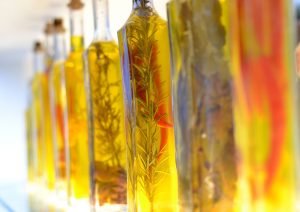Bulletin #4385, Safe Homemade Flavored and Infused Oils
Food Safety Facts
Developed by Jason Bolton, Assistant Extension Professor and Food Safety Specialist, University of Maine Cooperative Extension. Reviewed by Alfred A. Bushway, Professor Emeritus Food Science and Human Nutrition, University of Maine.
For information about UMaine Extension programs and resources, visit extension.umaine.edu.
Find more of our publications and books at extension.umaine.edu/publications/.
Flavored or infused oils can add excitement and new tastes to your meals. They can be used in salads, marinades, sauces, and dips. But, like many other low-acid homemade foods, infused oils can pose food safety risks.
The primary concern with infused oils is the extremely dangerous and sometimes deadly microorganism, Clostridium botulinum (C. bot), which can cause botulism. The fresh vegetables, herbs, and/or fruits used to flavor or infuse oils can be contaminated with C. bot spores. Fresh produce also contains water, which allows bacteria such as C. bot to live and grow. C. bot thrives in an oxygen-free environment like oil. This is why flavored and infused oils must be made and stored correctly to prevent botulism poisoning.
When infused or flavored oils are manufactured commercially, the fresh, low-acid ingredients are acidified to prevent bacterial growth. This is particularly important when oil contains garlic. Commercial infused or flavored oils that have been acidified using an approved process can be stored at room temperature.
We do not advise home cooks to try to acidify foods. Acidification of food products should be supervised by a food processing authority. The safest way for home cooks to prepare flavored or infused oils is to use properly dried herbs, garlic, or vegetables. Since dried ingredients have no water, C. bot bacteria will not grow.
Note: The following instructions are NOT meant for retail products, ONLY home use.
Preparing Flavored and Infused Oils at Home
Start by washing, sanitizing, and thoroughly drying the container and lid of your choice. A glass container with a tight-fitting lid is best. Sanitize them in boiling water for 30 seconds. Remove them from the water, cool, and air-dry.
1. Best Home Method: Flavored or Infused Oils from Dried Spices
Using dried garlic and/or herbs is the safest way to make infused oils without acidifying the product. Fresh herbs introduce water into the oil, and dangerous bacteria need water to grow. Dried herbs and garlic add no water to the oil, so bacteria can’t grow.
Select a good-quality olive or other vegetable oil. Add your flavor additives to a clean container. Heat the oil to 180°F in a pot. Pour the oil over the dried additives, cap your container, and cool.
Storage
Store oil containing dry garlic, vegetables, and/or herbs in a cool, dark place. This helps keep the fat from going rancid. Rancid vegetable oil does not look or smell any different. However it has been linked to cancer and early aging. Do not store for more than three months. After three months, throw away any unused oil.
2. Flavored and Infused Oils from fresh, acidified ingredients
Oils infused or flavored with fresh garlic, vegetables, or herbs should be acidified using an approved process. Acidified food for resale needs to be tested by the Food Processing Authority for Maine to ensure that the pH is low enough to keep C. bot. from growing. For more information on making acidified oil for resale, see University of Maine Cooperative Extension bulletin #3101, Recipe to Market: How to Start a Specialty Food Business in Maine.
Please remember that the safest way to make flavored oils at home is with dried ingredients (method 1 above). If you decide to flavor oil with fresh garlic, vegetables, or herbs, use a pH meter. Begin by selecting a good quality olive or other vegetable oil. Thoroughly wash and dry the fresh flavoring ingredients. Garlic should be finely chopped or crushed. Add the cleaned ingredients to a clean container.
Choose a vinegar with four to five percent acidity. In a pot, heat vinegar to near boiling (190°F). Pour the hot vinegar over the infusion ingredients, cover, and cool. Once the mixture has reached room temperature, add your oil and replace the cover.
You need enough vinegar so that the finished product has a pH of 4.6 or lower. This will keep C. bot from growing. Test the pH with a pH meter for food safety.
Storage
Although we do not advise making oil infusions with fresh additives at home, refrigerating this kind of oil infusion immediately after preparation will reduce your risk. Refrigeration will slow bacteria growth. Refrigeration will also slow the process by which oils go rancid. After one month, the number of bacteria in the product can become a food-safety hazard and it should be thrown away.
Acidified garlic, vegetables, and/or herbs in oil should be refrigerated. Do not store for more than one month. After one month, throw away any unused oil.
Information in this publication is provided purely for educational purposes. No responsibility is assumed for any problems associated with the use of products or services mentioned. No endorsement of products or companies is intended, nor is criticism of unnamed products or companies implied.
© 2011
Call 800.287.0274 (in Maine), or 207.581.3188, for information on publications and program offerings from University of Maine Cooperative Extension, or visit extension.umaine.edu.
In complying with the letter and spirit of applicable laws and pursuing its own goals of diversity, the University of Maine System does not discriminate on the grounds of race, color, religion, sex, sexual orientation, transgender status, gender, gender identity or expression, ethnicity, national origin, citizenship status, familial status, ancestry, age, disability physical or mental, genetic information, or veterans or military status in employment, education, and all other programs and activities. The University provides reasonable accommodations to qualified individuals with disabilities upon request. The following person has been designated to handle inquiries regarding non-discrimination policies: Director of Equal Opportunity and Title IX Services, 5713 Chadbourne Hall, Room 412, University of Maine, Orono, ME 04469-5713, 207.581.1226, TTY 711 (Maine Relay System).


